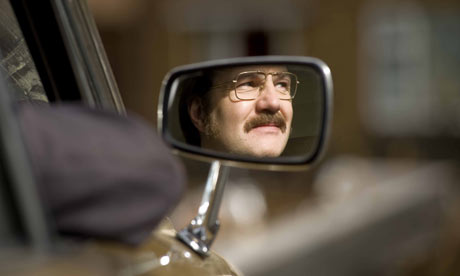We Are The Dead

Still getting aftershocks from the final episode of Red Riding on Thursday. Unsurprised my parents, dedicated viewers of Midsomer Murders and Poirot, were not only uninterested, but entirely unaware of it: Red Riding seems to slip outside of categories of what we refer to as 'crime drama' in this country, simply by virtue of playing the genre better than any of its so-called predecessors. One of the reasons for the feting of David Peace's novels was their perceived distance from the crime genre as such: they were held up more as iron-hard snuff-books, blood-and-guts for the arthouse crowd and politicos; something 'edgy'. Commentators saying this couldn't be more wrong: as Peace himself has argued, the Red Riding books are steeped in pulp, in crime tradition, influenced massively by James Ellroy, Raymond Chandler, George Pelecanos, Dennis Lehane, and that the genre needn't be ashamed of calling itself what it is: "Crime fiction has both the opportunity and the obligation to be the most political of any writing or any media, crime itself being the most manifest example of the politics of the time". Dealing as it does with the heaviest and most complex of material - life, death, sin, guilt, power - crime fiction and drama has enormous potential for reaching the places even poetry can't enter. Red Riding realised that potential by simply doing Waking The Dead's job, but better.
Most astonishing was the direction, cinematography and camerawork, which was easily the best I've seen in a television production for years. Heavy darkness, bleached-out colours, sudden slashes of light across rooms (as in Edward Dunford's torture sequence in 1974), bizarre focuses, sinister movements along walls, slow motion... by the second half of 1980, it already felt as if the viewer had ploughed stumbled into the heavy atmosphere of a dream, in which every gesture is imbued with a frightening significance (the red-moustached, vested cop, hammer in one hand, wiping a blood-stained hand over his face). It brings out precisely what k-punk discussed here: like Derek Raymond's similarly horrific 'Factory' tetralogy (note confluence: Factory, late 70s, the black and melancholy North), Red Riding is a metaphysical journey through a land of the damned all the more terrible for being the world in which we exist. The elements of fiction in the Red Riding novels are not quite so interesting as the facts, or rather the indistinguishability of the two: the recreation of the Yorkshire Ripper's interrogation is followed by actual footage of Sutcliffe being lead to Leeds central police station; the fictional Claire Strachan is surrounded by a litany of the Ripper's victims. The horrific geography of murder across Yorkshire, the map of taped-off blood-sites we see through Kemplay, Garland and Strachan, was substantially real. In Peace's world, the problem of evil is not one of abstract logic, but one the characters encounter materially, through eviscerated flesh, the inscription of power on the body through torture and rape. As k-punk puts it, we are "simultaneously drawn towards actuality and theology, as if the proximity of the one entailed the other". And if man alone is responsible for what goes on in such a world, there could be no bearing of it, let alone a telling. The increasingly contorted and entangled plot-lines - as if, with the bodies stacking up, it becomes impossible to see what is going on through all the blood - and increasingly murky, oblique and oneiric visual style, seem almost to suggest the characters surrendering their agency to another, impersonal force. The boundaries between the dead and the quick, between the past and the present dissolve: the psychic frantically scratching around on the floor, the visions of 'the others', the home-movie footage of BJ, and the lad himself, coming back to revenge the past...


0 Comments:
Post a Comment
<< Home